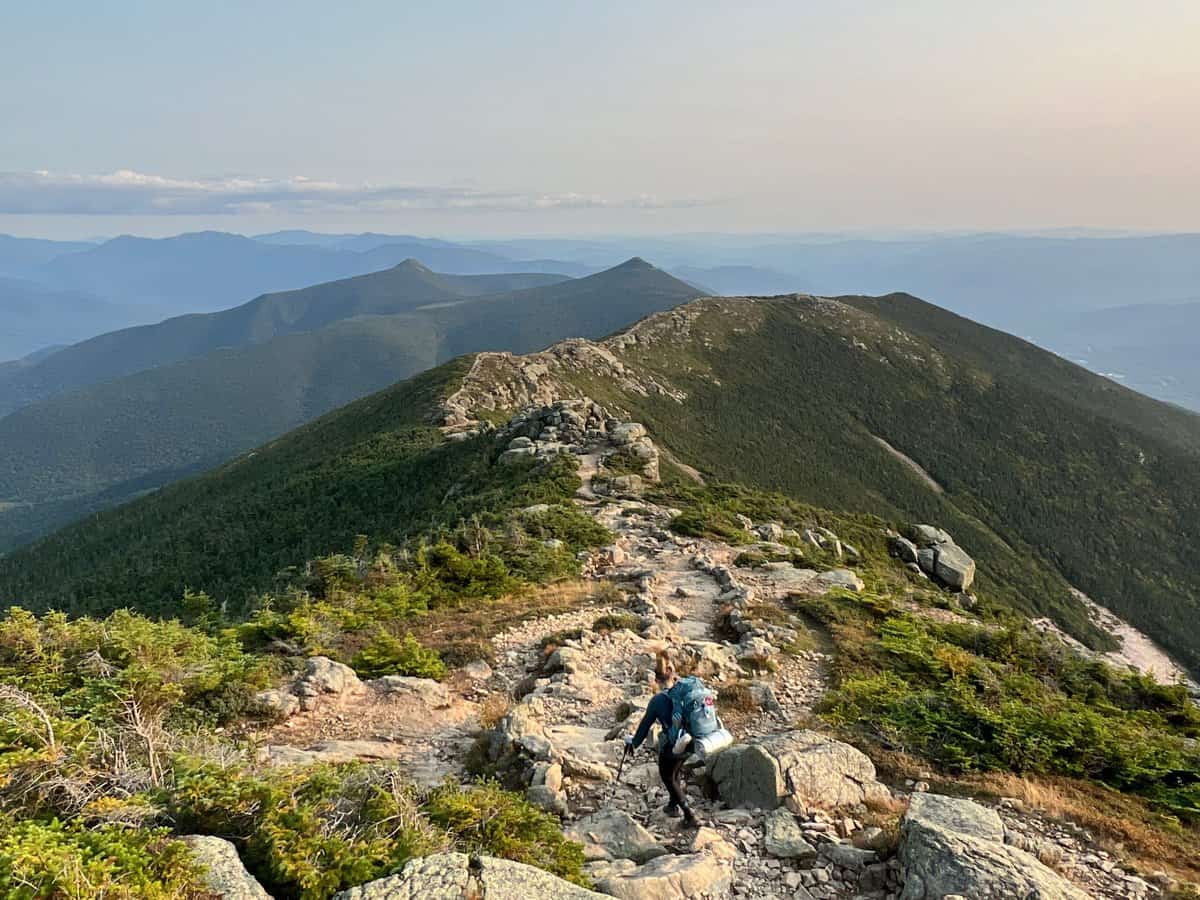Last updated on June 20th, 2025 at 08:55 am

Are you planning to tackle a thru-hike of the Appalachian Trail?
Hi! I’m Cindy of Cinders Travels, and the Locals Know Best podcast. In 2022, my husband Barrett and I completed our very own Appalachian Trail thru-hikes.
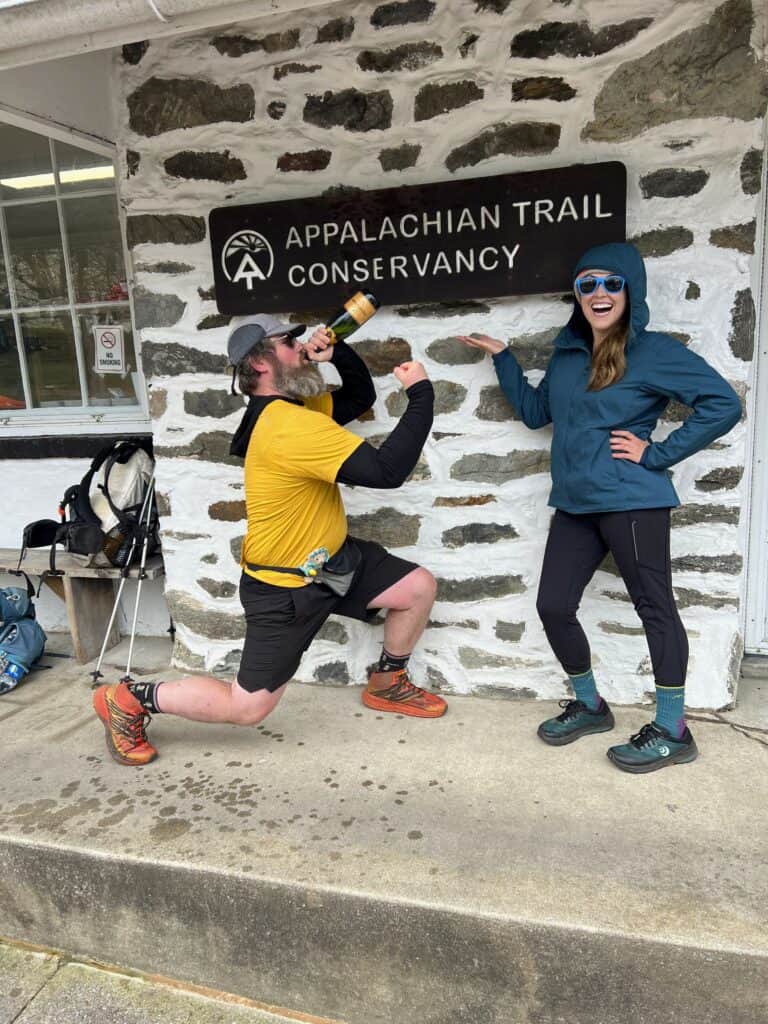
A thru-hike of the Appalachian Trail offers unique experiences, spectacular views, and ample opportunities for personal growth.
Whether you’ve been backpacking for years or just bought your first pack, thru-hiking the trail is 100% accomplishable!
However, it can be daunting to prepare for a thru-hike and estimate how long it takes to complete the entire trail.
Before you embark on this formidable adventure, it’s essential to understand the various factors that can affect the duration of your hike.
This article explores the key elements that can impact your hiking time from start to finish.
Numerous factors will influence how long it will take you to complete the Appalachian Trail. And each will play a role in determining how many miles you can cover in a day.
Some factors can be planned ahead of time, and managing those factors ahead of your hike will give you a huge leg up in the odds of being successful on the trail.
Those elements include hiking and pacing strategies, your level of physical fitness, some ahead-of-time climate awareness, and your gear. These elements can all make a difference in your pace along the Appalachian Trail.
Then some factors will occur throughout your thru-hike, and some will even be out of your control, such as the day-to-day weather, the terrain along the trail, injuries you may face, how often you need to take a break, the food you’re consuming, and your mindset throughout the hike.
Understanding all of these elements before heading out on the trail will enhance your Appalachian Trail experience, helping you better prepare for your adventure and set realistic expectations, giving yourself the best shot at a successful journey.
I aim to give you insights from my own thru-hike and tips to help you plan a successful Appalachian Trail adventure and effectively estimate your hiking duration.
So, lace up those boots, grab your pack, and let’s delve into everything worth considering when assessing how long the hike may take you.
A Few Basic Appalachian Trail and Thru-Hiker Facts:
Let’s quickly address a few basic terminology questions for anyone new to the Appalachian Trail and thru-hiking.
If you already know the answers to these, feel free to skip down to the next section.
What is the Appalachian Trail?
The Appalachian Trail is a hiking-only footpath following the stunning landscapes of the Appalachian Mountains throughout the eastern United States of America.
How Many Miles is the Appalachian Trail?
The length of the Appalachian Trail changes annually due to trail maintenance and reroutes.
Most recently, it has been measured at just under 2,200 miles long.
In 2024, the Appalachian Trail was 2,197.4 miles long. It was 2,198.4 miles long in 2023 and 2,194.3 miles long in 2022.
Where Does the Appalachian Trail Start and End?
The Appalachian Trail runs from the state of Georgia northward all the way up to Maine.
It passes through a total of 14 states along the path.
Which States Does the Appalachian Trail Pass Through?
The Appalachian Trail passes through the following 14 states: Georgia, North Carolina, Tennessee, Virginia, West Virginia, Maryland, Pennsylvania, New Jersey, New York, Connecticut, Massachusetts, Vermont, New Hampshire, and Maine.
What is the Definition of an Appalachian Trail (AT) Thru-Hike?
Annually, thousands of hikers attempt to hike the entire distance of the trail in 12 months or less to become an “AT thru-hiker.”
The Appalachian Trail Conservancy (ATC) is the organization that tracks thru-hikers.
Those hikers who complete the trail’s entire distance, in any direction, within 12 months receive a certificate for completing the hike from the Conservancy.
The Conservancy operates on an honor system, believing that, when you apply, you have “made an honest effort to walk the entire trail” between Katahdin and Springer Mountain within the 12-month timeframe.
What is the Difference Between an AT Thru-Hiker and a 2000 Miler?
Essentially, an AT thru-hiker and a 2000 Miler are the same thing.
A “2000 Miler” is merely an older term for a thru-hiker coined long ago by the Appalachian Trail Conservancy because it was initially estimated that the Appalachian Trail was 2,000 miles long.
Therefore, the ATC deems anyone who has hiked the entire Appalachian Trail part of the “2000 Miler” club.
How Do I Accomplish an AT Thru-Hike?
Okay, now that we’ve gotten some of the basics out of the way, let’s talk about how a thru-hike can be executed.
How Long Does Thru-Hiking the Appalachian Trail Take from Start to Finish?
You’ll commonly see, across the internet, websites saying it will take either 4-6 or 5-7 months to complete a thru-hike of the Appalachian Trail.
While a core “bubble” aims for four to six months, I wish someone had told us while we were planning that the honest answer is much more complicated and how long it will take depends on many factors.
When we started preparing, all the feedback we were being given by others who had accomplished the hike was that we would finish this hike in just about six months due to our specific age and shape. (Mid-30s and moderately fit.)
But honestly, no one knows.
And to a point, you can’t even know.
For those trying to break it down into a science, know there is much to consider when estimating how long a thru-hike will take.
Let’s go into those factors now.
From here, we will split the factors influencing the accomplishment of your thru-hike into two sections: Points to Address Prior to Starting Your Thru-Hike and Points to Address During Your Thru-Hike.
Understanding the Factors that Affect Hiking Duration on the AT Prior to Starting Your Thru-Hike.
Many factors affecting how long it will take to hike the Appalachian Trail can be assessed before leaving home. Those include:
🥾 Hiking Strategies and Pace
🥾 Your Physical Fitness Going into the Hike
🥾 The Seasons and Direction You Choose to Hike In
🥾 Your Gear
Let’s look into each of those further.
Hiking Strategies and Pace
How Many Miles a Day Do I Need to Average in Order to Thru-Hike the Appalachian Trail?
“What’s the average miles per day a thru-hiker hikes on the Appalachian trail?” is THE question.
In our experience, especially if you’re new to thru-hiking, your body will only be up for so much initially.
Thru-hikers generally start in a lower mileage range, hiking 8 to 10 miles per day, then increase their miles as their bodies allow, generally between 10 to 16 miles per day.
If you like to follow a pre-made plan, there are pre-planned guides out there, such as these 12 miles per day, 15 miles per day, and 18 miles per day guides on the A.T. Guide’s website.
- AntiGravityGear, LLC (Author)
For me, I felt a hiking guide/plan took away from the purpose of the hike.
As someone who avidly plans in daily life, I wanted the opportunity to fly more by the seat of my pants and have a new daily adventure while out there.
Because of our slower, less planned pace, we accomplished our thru-hikes as a flip-flop hike (Georgia to West Virginia, then Maine to West Virginia) in 7 months.
Did it take longer than we expected? Yes.
But we listened to our bodies and rested at least weekly along the way. I’m super proud of that.
Also, even though guides exist to get you to the finish line, life will happen along the trail.
You’ll meet a friend and want to hike their pace for a while or discover a new town you want to explore a bit longer than expected.
Try to avoid getting stuck in counting daily miles, and remember to enjoy the ride! You’ll likely only do this once and treasure it always!
How Many Hours a Day Should You Hike on the Appalachian Trail?
As many hours as you are capable of hiking, you’ll never regret starting early and resting your feet earlier in the day.
Is There a Time Limit for Finishing the Appalachian Trail?
While there is no time limit, there is one crucial deadline many hikers use as a finishing deadline when planning their thru-hike: Mount Katahdin’s winter closure for the season.
Mount Katahdin’s closure is a moving target, depending on the weather and when they deem it no longer safe to be hiked for the season, but generally, it is closed mid-October.
How Do I Create a Schedule for Thru-Hiking the Appalachian Trail?
The best way to create a schedule for thru-hiking the AT is to break down the miles by week or month.
Then, to stay on track, check how you are doing weekly or monthly and make the necessary adjustments.
Physical Fitness Preparation
How Much Prior Backpacking Experience Do I Need to Hike the Appalachian Trail?
Hiking experience will help, but is not required.
Anyone with backpacking experience will be in a great position purely due to their level of comfortability with their pack and gear.
However, if you have none, it’s still entirely possible. But I do hope you enjoy researching!
Researching strategies and gear before taking off will be your best friend and will help with keeping the learning curve low while you’re out there on the trail.
However, just like anything else in life that’s hard, you’ll never be fully “ready” for a thru-hike. You’ve just got to go for it!
How to Prepare Your Body for Thru-Hiking the Appalachian Trail
While preparing for our thru-hike, we went on weekly training hikes with weight in our packs, I weight trained, and we went on one three-day shakedown hike two weeks before we started our thru-hike.
Here is the breakdown of our weekly training hikes (which we adapted from Quadzilla’s training guide, which can be found here):
Week 1: Hiked with 15 lbs for 3 miles
Week 2: Hiked with 15 lbs for 4 miles
Week 3: Hiked with 15 lbs for 5 miles
Week 4: Hiked with 15 lbs for 6 miles
Week 5: Hiked with 25 lbs for 5 miles
Week 6: Hiked with 25 lbs for 6 miles
Week 7: Hiked with 25 lbs for 7 miles
Week 8: Hiked with 25 lbs for 8 miles
Week 9: Hiked with 35 lbs for 6 miles
Week 10: Hiked with 35 lbs for 8 miles
Week 11: Hiked with 35 lbs for 10 miles
Week 12: Hiked with 25 lbs for 10 miles
As for my strength training…
Start Strength Training Before Your Thru-Hike
Strength training is a great way to set yourself up for success before your thru-hike.
At a minimum, I recommend starting at least three months before your start date.
My strength training also came from Quadzilla’s training plan, which can be found here.
I strength trained three times weekly and adjusted the weight and reps in his plan to the best options for me.
I’m convinced the only way I survived carrying my pack, especially in the beginning, was due to the hard work I put in before we started on the trail.
Seasons & Deciding When and Where to Start – AT Thru-Hiker Hiking Directions & Start Dates
When Should I Start My Appalachian Trail Thru-Hike?
You have a lot of choices when it comes to when and where you should start your Appalachian Trail thru-hike.
These are the questions I would address to figure out which option fits you best:
Are You Attached to Starting or Ending in a Specific Spot?
When we started as NOBO thru-hikers, my husband was highly attached to ending atop Mount Katahdin.
Yet, as we trekked north and understood more about our pace and hiking preferences, the idea of ending at Katadhin was becoming less appealing and more stressful daily.
For my husband, somewhere in Virginia, he concluded that what was most important was completing the entire trail healthily and together in a positive mindset.
He realized where we ended didn’t really matter anymore.
Once we reached Harper’s Ferry, West Virginia, we flipped up to Maine.
For the rest of our Flip-Flop hike back to West Virginia, we were both immensely happier because once we tackled Mount Katadhin, all that was left was returning to West Virginia and then home at our desired pace.
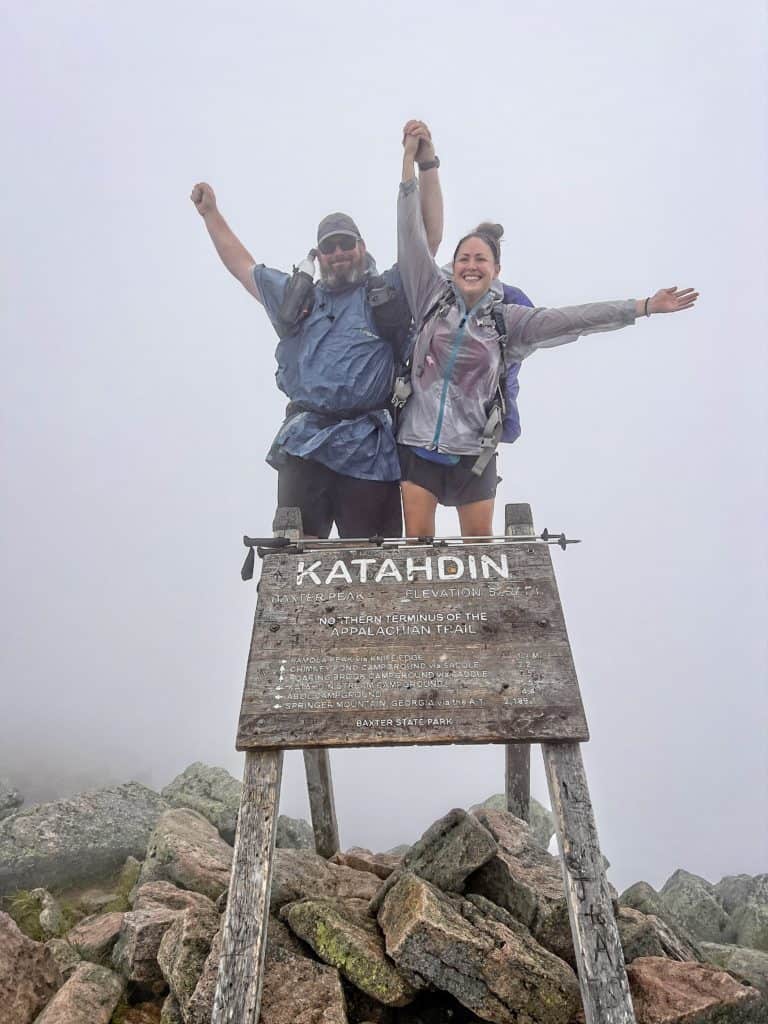
You have many more start date options for your thru-hike if you’re unattached to the idea of a specific finish line.
If you’ve read this, but nothing has changed, and you’re still attached to the idea of ending at Mount Katahdin, you should start hiking early enough in the year to reach it before it closes for the winter season.
The mountaintop is generally closed in mid-October. But know the closing date is a moving target, and the weather ultimately decides the annual closure date.
Are There Seasons You Prefer to Hike in?
What temperatures are you least interested in hiking throughout?
You can always plan a thru-hike to avoid the seasons you don’t want to endure and complete the entire trail within 12 months.
Is There a Best Direction to Hike the Appalachian Trail?
The best direction to hike the trail is up for debate. (Although Northbound (NOBO) is extremely popular.)
I will tell you what to consider for each direction.
NOBO (Northbound)
Northbound is far and away, the most popular direction to hike the Appalachian Trail.
Most thru-hikers pick this direction, and if being part of the social scene of the thru-hike is important to you, this is the direction you should choose.
Starting this hike in late winter/early spring means you will likely be able to avoid winter camping and hiking. The closure of Mount Katadhin will be your goal deadline while hiking in this direction.
When Should Northbounders Start Thru-Hiking the AT, and What are the Best Starting Dates for Northbounders?
The best time of year to start a northbound thru-hike in Georgia is Late February, March, or Early April.
A traditional NOBO hiker starts in early spring and will avoid most of the winter season.
However, they will likely either start or end in some cold temperatures and must be prepared gear-wise accordingly.
SOBO (Southbound)
A small percentage of thru-hikers opt for a Southbound thru-hike every year.
When hiking SOBO, you are starting out on the most challenging terrain.
While you can start NOBO and slowly work up your endurance and fitness level along the trail, most people who start SOBO are already in tip-top shape and ready to start on some of the most challenging portions of the trail from the get-go.
When Should Southbounders Start Thru-Hiking the AT, and What are the Best Starting Dates for Southbounders?
The best time of year to start a southbound thru-hike in Maine is June.
Mount Katahdin should be defrosted and open by then, and hikers hiking this route often aim to be done in time to be home for the holidays.
Flip-Flop Hiking the Appalachian Trail
There are a few different ways a Flip-Flop hike can go down.
I will discuss the two most popular flip-flops, but be aware flip-flops can happen anywhere along the route.
Also, don’t let anyone give you guff about considering a flip-flop hike.
While they are not as popular, they feel just as fabulous at the end, and you’re still accomplishing the same feat every other thru-hike is accomplishing.
West Virginia/Mid-Trail to Maine, then West Virginia/Mid-Trail to Georgia
The most popular direction for a flip-flop hike is West Virginia (or mid-trail) to Maine and then West Virginia to Georgia (but by a small margin.)
This is a fantastic option for hikers who want the best weather and don’t care about being in the bubble.
The Best Starting Dates for West Virginia to Maine, then West Virginia to Georgia Flip-Floppers:
April or May.
Georgia to West Virginia/Mid-Trail, then Maine to West Virginia/Mid-Trail
This flip-flop is another fantastic option for those hoping to hike in the best weather.
It’s also a popular redirection option for hikers who start NOBO and, by mid-hike, have concerns about reaching Mount Katahdin before its closure.
That is precisely what happened to us.
Our bodies told us we were done earlier than we wanted a lot in the first few months, and we truthfully only hit our huge mile days pretty late in our hike, the last month or two.
Mid-hike, we became concerned about reaching Katahdin in time. Our hike was in a sour patch. Everything was dictated by this closure time.
We realized we’d enjoy it much more if we flipped, so we did!
The Best Starting Dates for Georgia to West Virginia, then Maine to West Virginia Flip-Floppers:
April or May.
What is Section Hiking the Appalachian Trail?
Section hiking is a fantastic way for many people to hike the trail and should not be overlooked.
Not everyone can take half a year off to hike across America. If that long of a stretch doesn’t work for you, it shouldn’t stop you from reaching the goal of accomplishing this hike.
Hiking the entire distance of the trail is incredible, whether you did it in one year or spread out over 20!
Hike your own hike, and do what fits your life best.
One of the blessings of hiking this way is you can pick the best weather to complete your section each year.
Gear
Having quality gear is super important. So is having lightweight gear.
Often, it can be expensive to have high-quality and lightweight items, and you end up being forced to compromise.
👉 If you’re trying to figure out what gear items work best for a thru-hike, check out my ultimate gear guide, reviewing every gear item worthy of contemplation for an Appalachian Trail thru-hike.
You won’t use every item in this guide, but they’re all worth your consideration.
When choosing what to hike with, remember it’s a good idea to carry at most 20% of your body weight.
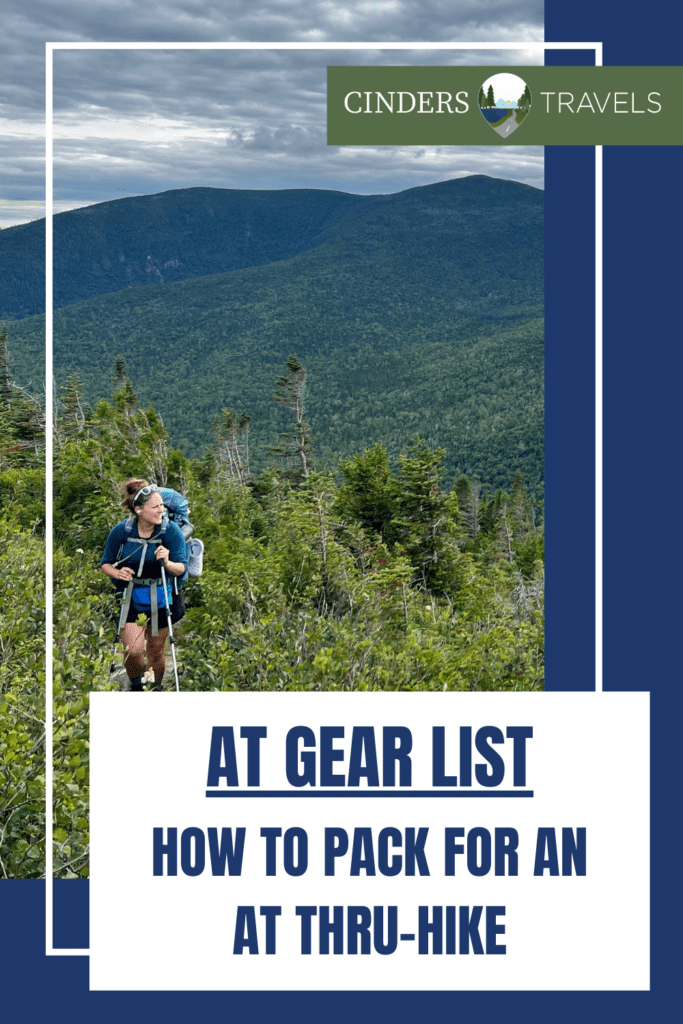
What is the Best Appalachian Trail Map?
The best maps and guides available for thru-hikers are Farout and the A.T. Guide (AWOL guide).
The digital version of the A.T. Guide, aka the AWOL guide, is excellent for planning resupplies, where to stop for the night, and finding viewpoints.
- AntiGravityGear, LLC (Author)
Because hikers frequently update the comments in the Farout app, it’s excellent for matters that change annually, such as whether or not water sources are dry and shuttle drivers are still driving.
👉 Click here for further details on both options.
Understanding the Factors That Affect Hiking Duration on the AT During Your Thru-Hike
You cannot prepare ahead of time for everything.
Many factors will pop up along your thru-hike that will also influence how long it will take you to accomplish your thru-hike, including:
🥾 Weather
🥾 Trail Terrain and Condition
🥾 Injuries
🥾 Zero Days and Resupplies
🥾 The Food You Consume
🥾 Your Mental Mindset
Let’s look more into these factors.
Weather Conditions
Ah, weather. My trail name is “Radar” due to being a bit obsessive about the weather.
At first, on the trail, I tried to orchestrate our hiking around the weather.
Eventually, though, we were hiking in almost any weather conditions by the end.
We reached a point where we couldn’t keep pausing for the weather, or we would never make it home before winter.
However, if you hike faster, with a lighter load, more than likely, you can sit out storms more often.
Terrain, Condition of Trail and Elevation
The Appalachian Trail traverses diverse terrains, with each state offering different adventures.
For example, Pennsylvania is notorious for its rocks, and Vermont for its mud.
However, what shocked me most on the Appalachian Trail was how many ascents and descents we tackled.
Before starting this journey, I had it in my head that we would see a ton of mountains and likely wrap around the sides of them often (as is popular on the trails out west that are graded for livestock).
That was not the case on the Appalachian Trail.
The Appalachian Trail has ~40% more elevation gain and loss than the Pacific Crest Trail. (515,000 feet on the AT vs. 315,000 feet on the PCT.)
If you’re going to come across a mountain, you better believe you’re hiking to the top of it and every other peak you see along the way.
Steep ascents and descents can slow your progress, while flat or downhill sections may allow for faster hiking.
Northbounders will get a healthy ramp-up.
Southbounders will be thrown into the crazy right off the get-go.
Injuries
Nobody wants to talk about injuries, but they happen daily, on and off the trail.
An injury will set you back and can even completely take you off the trail.
Be mindful of doing everything in your power to stay uninjured, but also accept that you can become injured at any time on the trail and may have to readjust your plan due to even minor injuries.
Zero Days
Zero days are the days you are not hiking.
Hikers often rest on these days, but they’re also not all rest. Commonly, these are the days hikers are also resupplying their food, swapping out gear, taking a long coveted shower, etc.
An easy way to think about zeros is that the more days you take off, the further you’ll have to hike on your hiking days to accommodate for the zero days you took.
Resupplies
Depending on how much food you want to carry and how often you wish to take a zero, you will likely need resupplies along the way, between zeros, on hiking days.
These days will often shorten your hiking days in terms of miles because of the time and logistics involved in getting in and out of trail towns.
Food
Eating well throughout your thru-hike can be a challenge.
However, it’s worth the effort to make it happen because quality food will give you the energy levels you need to hike further each day and accomplish your thru-hike.
You’ll want to find food that provides ample energy while remaining low in weight.
I recommend exploring GearSkeptic’s Hiker Food Chart 2.0 video and chart for further food advice.
Mental Mindset
Your mental mindset and the people you keep in your corner are essential.
Believe it or not, your mindset will play a massive part in whether or not you accomplish your thru-hike.
Everything else mentioned in this post is hugely beneficial, but if you don’t want to be out there and accomplish this goal, you won’t.
Here are a couple of tips to keep your head in the game when the going gets tough:
Staying in Touch with Friends and Family
There will undoubtedly be at least one person back home who is blown away by you tackling this feat!
Keep in touch with them in whatever way works best for you.
Some ideas on how to do this:
⭐️ Send them postcards along the way.
⭐️ Give them a call on zero days.
⭐️ Set up a Farout account and share your status along the trail with your closest friends and family.
Having A Support Person Back Home
Having a cheerleader back home is incredibly helpful.
Every day, especially in the beginning, you’ll mentally have moments where you question everything you’re doing and want to quit.
Prepare your person back home to stay mentally strong for you so someone is in your corner when you’re at your lowest.
Also, having someone who can help you do gear swaps, as you find out what you like and don’t, and for the seasons, is helpful.
Find a Hiking Partner or “Tramily” Along the Appalachian Trail.
It’s possible you don’t know another person wild enough to want to take on this endeavor with you.
That’s okay because thousands of people take it on every year!
Shelters and the trail itself provide ample opportunity to meet your fellow thru-hikers and form bonds.
This is especially true if you start as a NOBO thru-hiker in the spring.
Everyone in the first few hundred miles wants to get to know everyone else out there who is also trying this feat!
Appalachian Trail FAQs
Here are a few other answers to the questions I’m most often asked about the Appalachian trail and thru-hiking:
Can I Avoid the Crowded Conditions While Hiking the Entire AT?
It is possible.
First, don’t start a NOBO thru-hike in early spring.
Unless you’re super speedy, you’ll likely be caught up in the hiker “bubble,” possibly for your entire thru-hike, depending on your pace.
Look at the thru-hiker registration chart on the ATC website to see the dates most of the pack is starting their treks.
For those who want more solitude on their journey but still want to hike NOBO, your best bet would be to start hiking before the bubble.
(After the bubble is a second choice, but depending on your speed, be aware you may catch up to them.)
If the direction and ending location matter to you less than avoiding the crowd, you should spend some time thinking about a Flip-Flop or SOBO hike instead of a NOBO hike.
You can get an idea of annual thru-hiker patterns by visiting Raincrow’s “Where Are The Hikers?” heat map. This map gives you a general idea (from past data) of where hikers are usually found throughout the year.
Do I Have to Register My Appalachian Trail Thru-Hike?
You do not.
That said, the ATC would like to consider registering with them online ahead of time to help them keep an eye on the hiker bubble and manage the impact the hikers will have each year.
You can find more details on ATC thru-hiker registration here.
Will Permits be Required on My Appalachian Trail Thru-Hike?
A few permits will be required along the way for your AT thru-hike, but they are nothing to worry about.
Here are the few sections you will have to have a permit:
📝 Great Smoky Mountains National Park 📝
Prior to arriving at Great Smoky Mountains National Park, you will need to apply for their Appalachian Trail Thru-Hiker Backcountry Permit.
The permit is easily obtained online up to 30 days before arriving at the park. You must also print the permit in a trail town before arriving at the park.
The permit costs $40 and expires 38 days from the date you received it, meaning they allow you eight days to hike through Great Smoky Mountains National Park.
You can find more information on GSMNP’s Appalachian Trail Thru-Hiker Backcountry Permit here.
📝 Shenandoah National Park 📝
At Shenandoah National Park, you’ll reach either a ranger or (more likely) a pole at the entrance with a Backcountry Camping Permit form inside of it.
All you have to do is fill it out and carry it. There is no fee for this permit.
📝 Mount Katahdin in Baxter State Park 📝
Appalachian Trail thru-hikers must acquire a free AT Hiker card in person at the Katahdin Stream Campground Ranger station prior to heading out for the summit of Mount Katahdin.
You can find more information on the Baxter State Park AT Hiker permit card here.
How Many People Have Hiked the Entire Appalachian Trail?
The ATC started recording those who completed the entire trail in 1936.
Since then, just over 20,000 people have been recorded as completing the entire trail, including thru-hikes and section hikes.
What is the Meaning Behind the Saying “Hike Your Own Hike?”
To carve out your own path and live your own journey.
Before and during your hike, you will encounter friends, family, and strangers with opinions.
I like to think that most people have the best of intentions when giving input, but the fact is, the pool of people who have completed this hike is small.
And even for people within that pool, everyone is distinct. Their bodies are different, and their minds are different.
They’re doing their best when imparting advice, and feel free to take some into consideration, but at the end of the day, hike your own hike! Do what’s best for you and what’s working for you.
It’s a great saying that could be applied in many more aspects of life, IMO. There is only one of you.
Is Hiking the Appalachian Trail Worth it?
If you want to take some time out of the hustle and bustle of life and prove to yourself that you can do something challenging yet incredible, then yes, hiking the Appalachian Trail is absolutely worth it.
You must have a passion for completing the hike.
Whether the trail was more mentally or physically demanding, it’s a toss-up, but I lean toward mental.
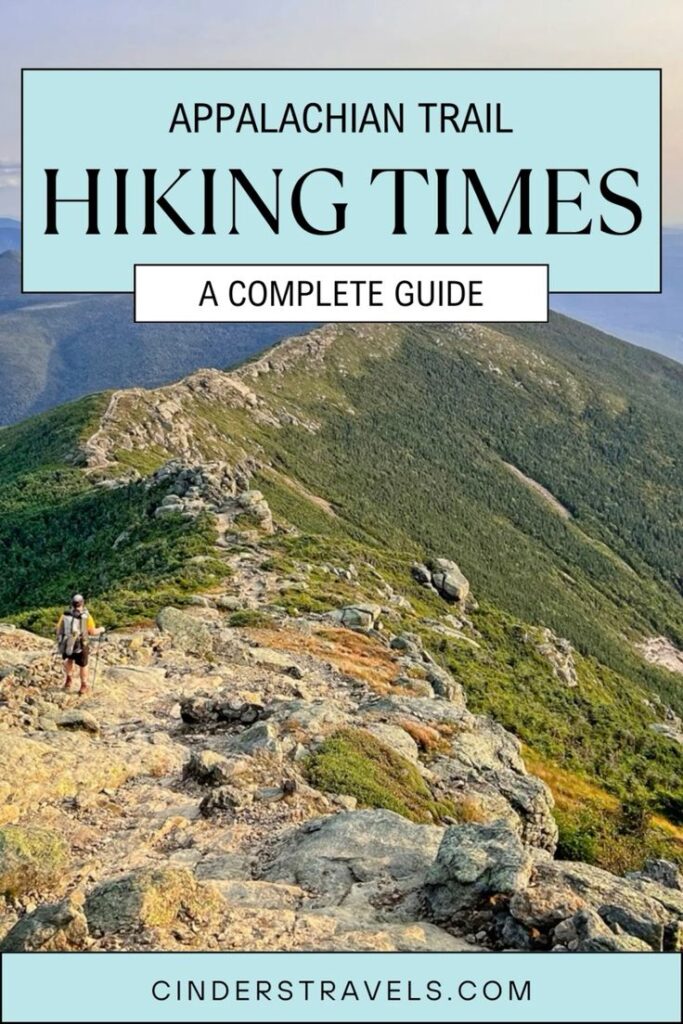
Conclusion: How Long Does it Take to Hike the Appalachian Trail?
There you have it, the factors that impact your hiking duration on a thru-hike of the Appalachian Trail!
By better understanding these factors, you can plan your hike more effectively and set realistic goals.
Now, you’re ready to embrace the challenges, soak in the breathtaking scenery, and create unforgettable memories along one of America’s most iconic trails.
You may also enjoy:
⭐️ A Complete Appalachian Trail Gear List: Realistic Packing for an AT Thru-Hike in 2025
⭐️ A Local’s Guide to the Best Mount Rainier Hikes
⭐️ 70+ Awesome Things to Do in the Black Hills for Outdoor Adventurers
- A Complete Two-Day Guide to Visiting Death Valley from Las Vegas - December 16, 2025
- Hiking the Appalachian Trail: Week 9 – Grayson Highlands Ponies & Longhorns - November 30, 2025
- Appalachian Trail Hike Week 8: Roan Highlands, Rain, & Renewed Motivation - October 22, 2025

